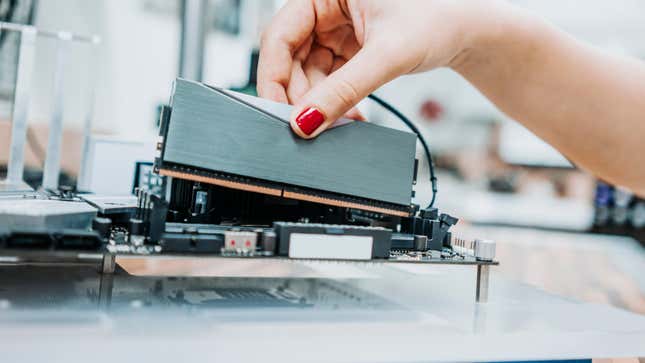
New chip making techniques, faster SSD storage, and the use of AI and machine learning are some of the latest innovations helping increase the performance and efficiency of modern computers, and now a research team at Lancaster University in the U.K. might have invented the next big thing.
It’s called UltraRAM and it combines the best of RAM and SSD storage to deliver an ultra-fast version of RAM that doesn’t dump data when turned off. But let’s rewind for a second and look at the two most commonly used components today.
If you own a modern laptop or desktop, it most likely contains a solid state drive, or SSD. This component, which uses flash memory, is called non-volatile because it retains information after you shut down your computer. In contrast, if you tried to save files onto RAM, a form of volatile memory, they would disappear the moment you cut the electrical connection.
For this reason, RAM in consumer products stores data only briefly before it gets processed. Whenever you open a file or launch a program, that data is taken from your SSD (or HDD) and fed to fast-access RAM where it can be quickly handed off to the CPU. You could use non-volatile storage, like an SSD, to act as RAM, but even the fastest storage options are many times slower than DRAM.
And so we use storage and RAM separately, the former holding our precious files for months or even year while the much faster and more robust memory can read and write quickly to a CPU but lacks the ability to hold onto data when there is no power.
Scientists at the Physics and Engineering Department of the UK’s Lancaster University described in a research paper (via Tom’s Hardware) a next-gen version of non-volatile RAM, aptly named UltraRAM, that could store files without being fed power yet harness the speed of DRAM. One day, this “best of both worlds” component could serve as both the storage and memory of a computer, which is why it is being dubbed a “universal” memory type.

“Extrapolated retention times in excess of 1,000 years and degradation-free endurance tests of over 10^7 program-erase cycles prove that these memories are nonvolatile and have high endurance,” researchers wrote.
The science and techniques behind UltraRAM are much too complicated to describe in detail, so I encourage those who wants to learn more to read the research paper. The TL;DR version is that it uses specific properties of compound semiconductors typically used for LEDs and lasers to create a RAM/storage hybrid with the potential of being mass produced at a relatively low cost. The end product could eventually find its way into just about all the devices we use today, from smartwatches to consoles to data servers.
This all sounds mighty encouraging but it’s important to remember that many have tried and failed to bring this holy grail of RAM to market. Past attempts were either too expensive, too slow, or couldn’t be scaled. If the Lancaster University team can solve for those potential roadblocks then UltraRAM could eventually evolve how our gadgets operate.
“Eventually” being the operative words there: the researchers say they will continue to work to “improve epitaxial quality, fine-tune the fabrication process, implement a normally-off channel design and scale the devices.”